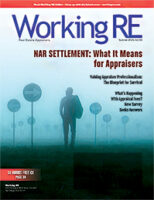 |
> The Appraiser Coach
> OREP E&O |
Appraisal Insights With Freddie Mac
by Scott Reuter, Freddie Mac
One of the goals at Freddie Mac is to help lead the way toward a more transparent and equitable housing finance process. Across our many priorities, we’re committed to offering trends, best practices and insight to the industry. As strategies continue to develop and evolve, we believe it’s important to engage and communicate with stakeholders, so here are three key items we believe appraisers should keep top of mind in 2024.
1. More Objective Appraisals
An important component to transparency is ensuring that appraisal reports for loans sold to Freddie Mac are free of subjective or potentially biased language. Incorporating potentially problematic words and phrases in reports not only undermines the credibility of the appraisal, it could potentially signal bias by the appraiser. When developing an opinion of value, appraisers must not consider (or suggest that they consider) any personal or demographic characteristics.
With this in mind, Freddie Mac recently enhanced feedback messaging in our technology tools to include warnings and hard stops to help lenders and appraisers identify potentially concerning or prohibited language. We’ve also developed resources and training to share our feedback messaging across numerous channels as well as offer practical examples of troubling language and how appraisers can address it.
For example, in a recent article titled “More Objective Appraisals: A Practical Guide for Appraisers,” I lay out some best practices appraisers can employ for writing more objective reports. These pointers include:
- Appraise the property, not the people.
- Don’t think like a salesperson. Avoid certain words that may be commonly used to market homes.
- Don’t copy and paste. Using old report templates as well as certain online sources can open the door to introducing problematic language.
- Pre-screen reports. In addition to a thorough review before any report leaves your office, work with your lender or appraisal management company (AMC) to help catch the use of these words early in the process.
The good news is Freddie Mac data suggests that recent actions lenders and appraisers are taking have led to more objective appraisals. We appreciate the efforts that appraisers, lenders, AMCs and others have made to support this objective.
2. Market Conditions Analysis
Market conditions analysis is the backbone of an appraisal. It’s a necessary step in developing credible reports. This analysis is the study of market area conditions and the changes in price levels over time. A comparable sale that occurred under market conditions different from those applicable to a subject property as of a certain date requires an adjustment for the differences noted. The movement in market conditions must be adjusted to reflect the changes (up or down) from the time a comparable sale went under contract to the effective date of the subject property appraisal.
A number of tools and resources are available to help appraisers with market analysis and adjustments. Many of these allow appraisers to interact with larger data sets to help objectively analyze relevant and specific data. Freddie Mac encourages appraisers to use these tools as well as other commercially available services, models and data sources, including multiple listing services and public records. We also provide a Freddie Mac House Price Index on our website here.
It’s important to note from a development perspective that market conditions must be analyzed on every appraisal assignment. Market adjustments should not be viewed as a filler adjustment. Market conditions adjustments are technically among the first modifications that should be made, before accounting for physical differences. Taking shortcuts here diminishes the reliability of the adjustments that follow and the overall credibility of the appraisal report.
Freddie Mac relies on appraisers to develop appropriate analysis for each assignment. Sound and credible appraisals are an important part of our overall risk management. Look for additional guidance and more resources to come from Freddie Mac on this.
(story continues below)
(story continues)
3. Quality vs. Condition
While most appraisers demonstrate a solid understanding of the quality and condition ratings, Freddie Mac still sees inconsistencies in the way these are reported. As might be expected, most of the issues for reported condition fall between the definitional lines of C3 to C4 and C4 to C5. Understanding that rolling multiple components of differing conditions into a single rating can be challenging, the terms and phrases in the written definitions are designed to be straightforward and absolute.
For example, since Freddie Mac won’t purchase loans when a home is in C5 condition (For additional information, consult Freddie Mac’s “Appraisal Report and Property Eligibility FAQ” online), the C4 to C5 distinction is very important. The written definitions distinguish a C4 property being “adequately maintained” and a C5 “not being adequately maintained.” The definition goes on to describe a C4 condition as generally well-kept and in need of minor cosmetic repair, whereas a C5 condition needs substantial repair. Taking a pause here and regrounding in the written definitions should help most appraisers.
Also, there seems to be a notion by some appraisers that a C3 condition is equal to “average.” Please be mindful that a C3 home is described as generally well-maintained and showing minimal physical depreciation from regular wear and tear. In contrast, a C4 condition applies to a home that’s adequately maintained, has slight deferred maintenance and minor physical wear and tear, and may need cosmetic or minor repairs.
Further, there’s also a recent trend in which some appraisers have been conflating quality and condition—letting one influence the other. An example of this is a statement such as: “Although the home is new, the kitchen was noted to be of lower quality and cost; therefore, the condition rating is C2.” New is new. A brand-new home is brand new and should have a C1 rating, regardless of the quality of construction. If needed, appraisers can separately consider and address the quality of the kitchen.
These are just three important topics appraisers should keep in mind this year. To learn more as well as subscribe to receive emails with timely information on trends, best practices and insights, visit the “Collateral Valuation and Appraisal Resources” page on the Freddie Mac website here.
About the Author
Scott Reuter is single-family chief appraisal officer for Freddie Mac. He is a certified general appraiser with more than 30 years of experience in valuation, appraisal and collateral risk management concerns. His team leads the effort for ongoing development and refinement of property valuation risk management strategies, underwriting products, and establishing and maintaining a credible quality assurance process across multiple lines of business support. For more information, visit Freddie Mac.
OREP Insurance Services, LLC. Calif. License #0K99465



